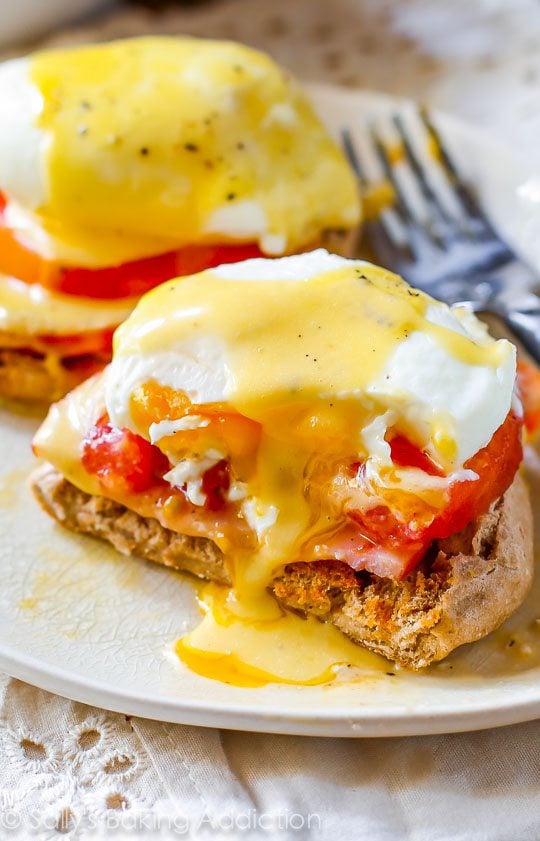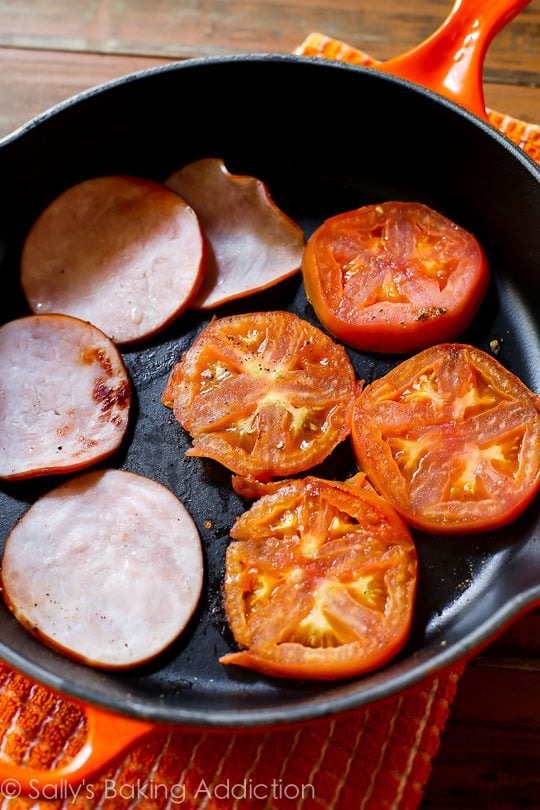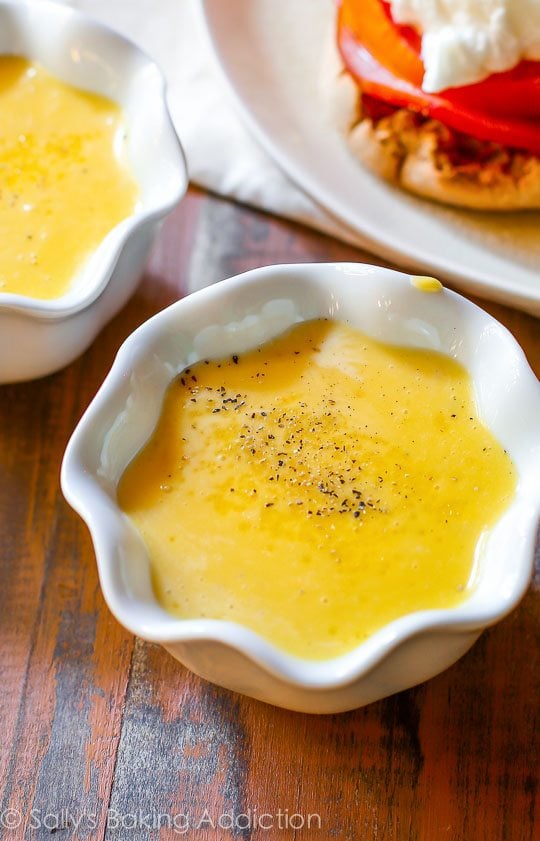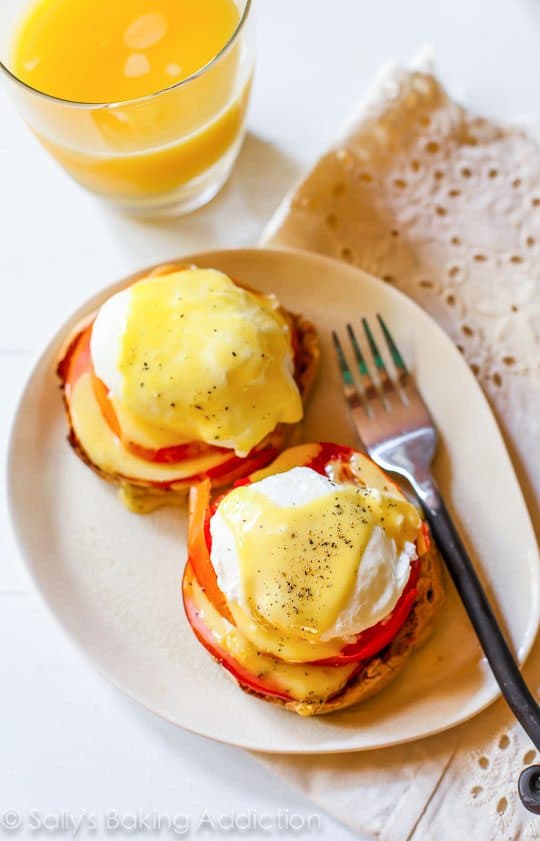Let’s talk about weekend breakfasts. Are you a savory breakfast person or a sweet breakfast person? A savory quiche recipe with a crispy hash brown breakfast skillet or a stack of buttermilk pancakes with a side of cinnamon rolls? Or are you a “nothing because I’m still half asleep” person? That would be my husband! I’m most definitely a sweet breakfast person, surprise surprise. However, there is one exception: Eggs Benedict is my favorite! Luxurious eggs benedict is one of life’s simple pleasures. It’s just guaranteed to make your mornings spectacular, but many people never take the time to prepare this brunch standard at home. Let’s change that! When you spend time making silky hollandaise sauce or perfectly poaching the eggs to get that magnificent runny egg yolk, you might appreciate this breakfast and the entire experience of preparing it… even more. I’ve had eggs benedict many ways. My favorite is topped with jumbo lump Maryland crab and Old Bay. I’ve also had eggs benedict with sliced avocado on top and nearly lost my mind it was so good. And (last one, promise) I also like eggs blackstone—ever try that? It’s the same as eggs benedict but there’s crispy bacon instead of Canadian bacon. And there’s a tomato slice, which is the red you see in my eggs benedict today. I now love preparing eggs benedict with a thick, peppered tomato slice. Let me walk you through a few things before you begin the recipe. Homemade hollandaise. This is a recipe I’ve been making for awhile. Melted butter, egg yolks, a touch of lemon juice, salt, and pepper. That’s all. The trick here is to melt the butter first. Do that before anything else. Then, let the butter cool as you poach the eggs. You absolutely do not want your melted butter to be scorching hot because it will cook the egg yolks. Resulting in a chunky, strange, not at all appetizing hollandaise sauce. Oh, and I make my hollandaise in a blender. I learned this method from talking with a William’s Sonoma employee. Totally normal to somehow get in a conversation about hollandaise while at the mall. Poached eggs. Ok, I began typing this post one morning after having 3 cups of coffee. And the more I worked on it, the longer and more drawn out this poached egg paragraph became. Apparently I’m pretty chatty about eggs. So, I’ll let you poached egg experts skip all that and just make the recipe below. But for anyone learning how to make the perfect poached egg, see my poached egg spiel. Besides homemade hollandaise and poached eggs, you’ll need a toasty english muffin and a thick slice of Canadian bacon. If you care to try my tomato addition, you’ll need 2 tomatoes as well. I like to lightly cook the sliced tomatoes and brown the Canadian bacon before adding to the eggs benedict. A little sprinkle of pepper adds flavor. Sure this breakfast is incredibly rich, but enjoyed every now and then? Makes it even more special. Treat yourself to a lavish Sunday morning meal. And maybe even eat it in bed. 😉 Enjoy! For another egg-based breakfast recipe that’s excellent for breakfast all week long, try these customizable breakfast egg muffins next!
Poached Eggs
Poached eggs are easier than you think to master. I know it seems difficult and “why not just make scrambled eggs, they’re easier” but the runny egg yolk (!!!) is the best part. There are so many different tricks and techniques I’ve read about and I’m sure there are more that you will share with me. Feel free! I am absolutely no expert on poaching eggs, but what I’m sharing is just the way we poach eggs. As with most cooking and baking, practice makes perfect. It took me a few tries to get the perfect poached egg, so don’t get discouraged. They won’t all be perfect at first.
- Watch this video from professional chef Jamie Oliver about poaching eggs. It is so helpful and will give you visuals of what you’re doing.
- Start with the freshest of fresh eggs. Absolutely positively the freshest eggs you can. I try to grab a carton from the very bottom or the very back of the egg selection in the store. They’re always the freshest. Why the freshest eggs? The fresher the egg, the more firm and sturdy the egg white.
- The pot. Some people prefer wide skillet pans, but I prefer a deep pot. Especially when I’m poaching more than a couple eggs at a time. Fill a pot with 3-4 inches of water. Heat the water on high until it reaches a bare simmer and bubbles start appearing at the bottom of the pan. Just before boiling. If you care to be extra precise, you’re looking for about 190F degrees.
- At this point, add 2 teaspoons of distilled white vinegar. Jamie says he does not do this because it makes your eggs taste like vinegar, but I do not think the eggs taste like vinegar at all. I also use a very small amount for 8 eggs (if making 4 poached eggs, reduce white vinegar to 1 teaspoon – if making 2 poached eggs, reduce to 1/2 teaspoon.) Some people, like Jamie, are very anti-vinegar, but I find my poached eggs turn out best with this little addition. Especially if (1) your eggs aren’t straight-from-the-chicken fresh and (2) when I’m making more than 1 or 2 poached eggs at a time. The vinegar helps reduce the “feathering” of the egg white when it’s dropped in the water as well as prevents the egg white from sticking to the bottom of the pot. 5) Working with one egg at a time, crack the egg into a small bowl or cup. Place the bowl close to the surface of the hot water and slip the egg into the water. Repeat with 3 more eggs. I only like to poach 4 eggs in the pot at a time. NOTE! Some people swear by the “whirlpool” method. Basically, you create a whirlpool in the center of the barely simmering water and gently drop the egg in the whirlpool. This helps the egg white wrap around the yolk. Jamie shows the whirlpool trick at the 2:00 minute mark of the video. I’ve tried both ways (whirlpool vs no whirlpool) and honestly do not find it necessary. However, try it if you’d like.
- Turn off the heat and cover the pot. My preferred cook time for poached eggs is between 3:30 – 4 minutes. So, set a timer for 3:30 minutes. If the egg white around the yolk still looks translucent, give it an additional 30 seconds. If you like your eggs more done, cook for 4 – 4:30 minutes. After 4 minutes, the egg whites should be completely cooked with the egg yolks still runny. PLEASE NOTE that the time depends on the size of the eggs, if they were cold or at room temperature to begin with, and/or if you are cooking at high altitude (in which they’d likely need to be cooked a little longer). If you find 3:30-4 minutes is too long for your eggs and the yolks aren’t runny enough, reduce the time by 30 seconds in your next batch.
- Gently lift the poached eggs out of the pan with a slotted spoon and place on a paper towel lined plate. Sometimes I trim a bit of the excess egg white off around the yolk, though that is not necessary.
- If you are making 8 poached eggs, like my recipe above, follow the preceding instructions and then: Fill a large bowl halfway with water and add a handful of ice cubes. Poach the eggs as directed, then remove from the pot and slip into the ice water. When all 8 eggs are done, bring a pot of water to a boil, add the eggs and cook for 20 to 30 seconds to warm them up again. The eggs are best used the day they’re cooked, but they can be kept overnight in the ice bath.





